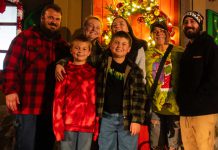Dear Editor,
At age 16, Emilio Paulo Orsetti, an Italian immigrant, leaves
Italy for a better way of life. He goes to Brazil, then Argentina.
Life is no better. In 1902 he decides to come to North America; he
wants a future. Emilio eventually finds Gilroy and works for Miller
and Lux from dawn to dusk for 99 cents a day.
Dear Editor,
At age 16, Emilio Paulo Orsetti, an Italian immigrant, leaves Italy for a better way of life. He goes to Brazil, then Argentina. Life is no better. In 1902 he decides to come to North America; he wants a future. Emilio eventually finds Gilroy and works for Miller and Lux from dawn to dusk for 99 cents a day. He meets Louise Garbarino, a young girl. She is a hard worker who has packed dried fruit, picked prunes, and works at the Biscegli Cannery; she can work twice as fast as the women around her. She is 15; he is 28.
They marry and have one goal – to overcome poverty. Word gets around they are hard workers and responsible. They save their money. In 1911, Emilio and Louise are encouraged to purchase 11.75 acres for $175 per acre on the south side of Buena Vista track for the down payment of a $50 gold piece. This land is used primarily to raise sheep and is occupied with oak trees, coyotes, skunks, rabbits, and squirrels. The purchase requires the land be planted in prune trees, so that is what they do. In 1920 they decide to buy another 10-acre parcel on Buena Vista. Prices have gone from $175 to $300 an acre.
Together they plant prunes and add a water supply to the land. Emilio builds a small ranch house and a barn. They eventually purchase the neighboring property. They have found their way out of poverty. They have an only child, a son, Emilio Aladino Orsetti. He is raised to be a hard worker as well.
Fast forward to the 1950s. Senior Emilio realizes he is too old to continue running the orchard and considers putting it up for sale. Son Emilio stops this sale and promises to continue the family’s dream. He teaches for Gilroy Unified but farms his father’s orchard after work. In 1965, with wife Teresa, they build their dream home behind his parent’s house. He is proud of his trees, his orchard, his heritage, and his home. He runs this orchard until the day he dies.
Fast forward to the 199Os. Emilio Jr.’s son lives in the original ranch house. Emilio and Teresa live in the middle home. His daughter and son-in-law decide to build their dream home behind the two houses in place. There are now three family homes in a row. All want to continue the family tradition.To this day they farm five acres of prunes, one of the last surviving original orchards in all of Santa Clara County. They are members of Sunsweet Growers.
Since childhood they have driven tractor, shaker, sprayer, forklift, and the old flatbed truck; they have moved irrigation pipes, pruned trees, picked brush, planted new trees, and harvested the crop. The trees are dormant in the winter surrounded by three to four feet tall yellow mustard blowing in the wind. In the spring the trees are blanketed in beautiful white blossoms before growing their green leaves and fresh fruit. Harvest is every late August or early September. They are Gilroy educators and an engineer by day; farmers by evening and weekends. It is a lot of work, yet it is all they know. It is all they want. This is the Orsetti history; this a piece of Gilroy’s history. This is my history.
Fast forward to Feb. 1, 2010, ironically the anniversary of my grandmother’s birthday. I sit in a Gilroy City Council meeting “study session.” I am aware a potential high speed rail route is near our land, down the street. Suddenly I view a new possible route for the rail system. It’s the “purple line” and it is not traveling up a rural road on Buena Vista but running right up our 1,000 foot private driveway, obliterating our three family homes, the original ranch barn, the original picker cabins, the equipment storage buildings, the orchard, our 90-year history. I try to make sense of it all, and for once I am glad my parents are gone.
My parents’ words reel through my head …”Change is the law of life”, “There will be a lot of changes in your lifetime, maybe in yours, but definitely in the kids’ lifetime.” “The city will come to you … the town is growing … hold on to our home place … Sell the rest if you have to, but hold on to our homes … our small Kennedy estate, our little peace of heaven … Save it for you; save it for the kids …”
Never did Mom or Dad say, “There will be a high speed train, traveling 220 miles an hour, hauling down what used to be our driveway, our homes, our original ranch buildings and orchard, our family’s lifestyle for 90 years; Oh, and it will be for the good of the people.”
In 25 months we lost three parents, three grandparents to my children. Two we lost to cancer. As I listen to this high-speed train plan unfold I see it only as another form of cancer. Silent at first … you don’t even know it’s there. Then it takes over slowly changing the form of everything around it before going in for the final kill. I think of the saying, “I feel like I’ve been hit by a train” which is usually meant as exaggeration, something that generally doesn’t happen. Or does it? This country community might literally be hit by a train, and the impact of the blow is insurmountable.
We need to band together; we need to have a community voice that speaks loud and clear. We need to stop this train before it derails all our hopes, our dreams, and our histories. Enough is enough. WE need to draw the line.
Marlene Orsetti Manzo, Gilroy











